
Small two-wheel-drive SUVs weren’t on the Australian motorist’s radar until a few years ago. Hatchbacks previously dominated the market but, with SUVs in general seeing a rapid rise in popularity, new models from the big carmakers have come in thick and fast. We put two of the best – Mazda’s CX-3 and Honda’s HR-V – up against the latest entrant from Hyundai, the Kona. While two of the three also offer AWD versions, it’s the 2WD petrol models that are proving the biggest hits.
| Specifications | Mazda CX-3 Akari | Hyundai Kona Elite | Honda HR-V VTi-L |
| Engine | 2.0-litre four-cylinder | 2.0-litre four-cylinder | 1.8-litre four-cylinder |
| Transmission | 6-speed automatic | 6-speed automatic | CVT |
| Power | 109kW | 110kW | 104kW |
| Torque | 192Nm | 180Nm | 172Nm |
| Fuel consumption | 6.1L/100km (claimed) | 7.2L/100km (claimed) | 6.6L/100km (claimed) |
| ANCAP | ★★★★★ | ★★★★★ | ★★★★★ |
| Price | $33,490 (plus ORC) | $28,500 (plus ORC) | $33,340 (plus ORC) |
All three SUVs come well specced and the standard features are extensive on the models we drove – all have dual-zone climate control air conditioning, large infotainment screens and keyless entry – but how does how the newcomer stack up against two of its best rivals in all other respects?
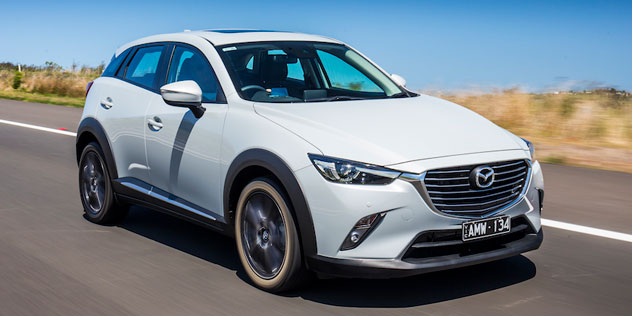
Mazda’s smallest SUV was an immediate hit when launched in 2015, racking up back-to-back wins in the small 2WD SUV category of the Australia's Best Car awards. The line-up has 14 variants covering all bases, starting with the CX-3 Neo 2WD ($20,490) and topping out at the CX-3 Akari diesel AWD ($37,890). We drove the Akari petrol 2WD ($33,490).
Powering the CX-3 is a 2.0-litre four-cylinder petrol engine developing 109kW and 192Nm, matched to a conventional six-speed automatic, driving the front wheels. Its claimed fuel consumption is 6.1L/100km. Mazda’s engines and transmission are technically at the forefront in this class and are works of art internally, employing high-tech materials to decrease weight and pumping losses without reducing performance. The CX-3 is the only one of the trio to feature an engine stop/start system, designed to improve real-world economy. It’s a system that’s divisive and engenders a love/hate relationship with buyers, but in the CX-3 the system fires the engine up in just 0.35 seconds and works as well as any from other carmakers.
As a driver’s car, the CX-3 has few SUV peers, and its on-road manners match its sporty good looks. The suspension design is straightforward enough: up front there are MacPherson struts and at the rear is a simple torsion beam. The design works well, delivering a decidedly sporty chassis, and the low-profile tyres fitted to the Akari don’t upset its ability to soak up bumps and potholes on poor quality sections of road. Performance from the 2.0-litre is spirited, albeit a little noisy when the transmission upshifts under acceleration. This settles when cruising and, on our mixed drive loop, the CX-3 returned 6.7L/100km, highlighting the engine’s efficiency.
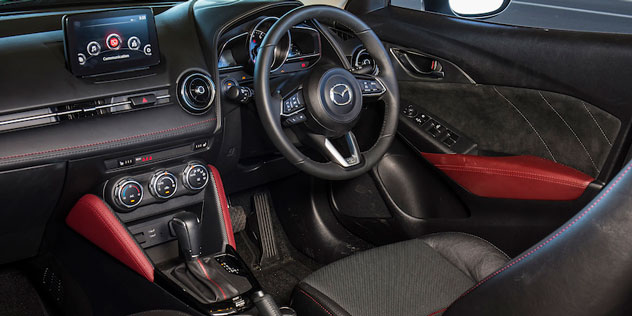
The interior delivers a wow factor equal to the exterior design. Front and centre is the seven-inch colour info display mounted in the top of the dash. You can navigate through the various functions via a rotary dial placed conveniently in the centre console. From an ergonomic and ease-of-use perspective, it’s one of the best systems in the business. The Akari also comes standard with a head-up display that shows speed, sat nav turns, and speed limits. The centre console lacks a storage binnacle or armrest for drivers and is the only real negative in an otherwise well thought out interior.
Seat comfort is above average in all positions and the leather facing provides good support, although larger occupants may find the front seats restrictive in the middle and upper back. The CX-3’s high tapering waistline means that second-row passengers get a slim view through the side glass and the cabin feels decidedly cosy from the rear. It was the only one of the trio where we had to move the front seat forward to provide enough leg room for an adult to be comfortable in the second row. Indeed, the CX-3 loses out to the others in space, especially in the cargo area. If you want to carry a set of golf clubs, you’ll need to fold down the second-row seat, and the length between the tailgate and the back of the rear seat proved the shortest according to our measurements.
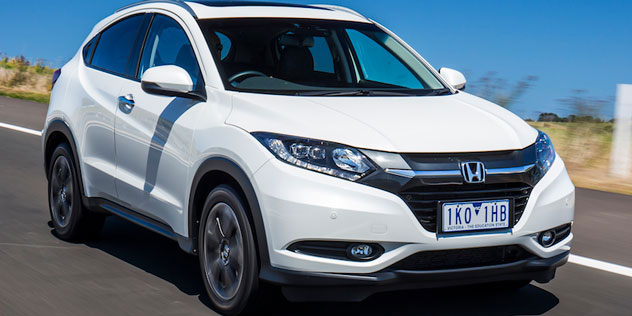
Honda’s HR-V range was reintroduced in 2015 after an absence of almost 18 years, when models like the larger Honda CR-V filled the brief, and it was just the model Honda needed to boost its stocks in the booming small SUV market.
The new line-up isn’t as expansive as the CX-3’s and there are no AWD versions, manual transmissions, or diesel options. Prices start at $24,990 for the VTi and go up to $34,915 for the VTi-L ADAS (Advanced Driver Aid System).
Powering the HR-V is a 1.8-litre petrol engine producing 104kW and 172Nm, and it’s matched to a CVT transmission. Claimed fuel consumption is 6.6L/100km and the HR-V actually returned the best fuel figure of the trio at 6.5L/100km. Like the engine in the CX-3, Honda’s smaller 1.8 unit employs the latest engine design thinking to refine the combustion process, reduce friction, and improve consumption. Honda’s suspension design mirrors the CX-3 and Kona’s, with MacPherson struts up front and a torsion beam at the rear.
Over our test loop, the HR-V gave little away to the CX-3 or Kona in ride and handling. The HR-V felt the best at insulating occupants from road surface irregularities. At higher speeds and while cornering, the suspension still provided enough body control that the HR-V didn’t suffer excessive body roll or pitching. The HR-V had the lightest steering of the group, which is ideal in the car park and for low-speed manoeuvres, but provided little in the way of feedback or a connected feel to the road.
Honda’s smaller engine and CVT were much closer in performance to the CX-3 and the 2.0-litre in the Kona than expected. A CVT’s tendency to make an engine hold its revs is much derided in some circles, as it can result in a loud and constant drone under acceleration, but it’s not as obvious in the HR-V. This may be due to the additional sound-absorbing material underfloor and better electronics.
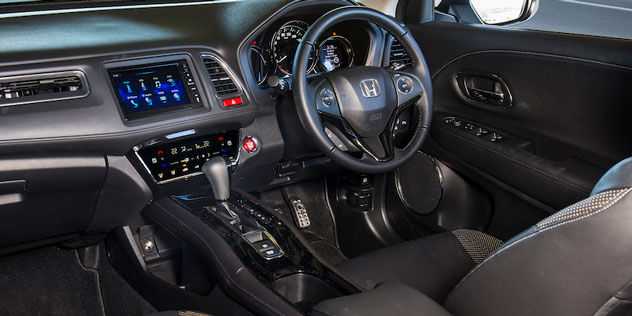
The cabin layout reflects Honda’s current design ethos and the interior is reminiscent of the new Civic and CR-V. The piano-black finish creates a sense of luxury, but objects placed on the centre console tend to slip easily. Honda overcomes this to a degree with an open area underneath, which is a better option for mobile phones and small objects.
Our only major gripe with the HR-V is the colour touchscreen audio display. Although it is Apple and Android compatible, its functionality tested us throughout the week – the matt screen and its positioning in the dash made it almost impossible to read in direct sunlight. The lack of a digital speed readout, present in the others, is also regrettable.
On a positive note, the HR-V is the only one to feature an electric handbrake and, if you’re after space and cargo carrying flexibility, it’s the pace setter. In the rear, the HR-V is the largest by a fair margin, and the second-row seating (Honda calls them ‘Magic Seats’) folds flat to provide an extensive cargo area. The seat base can be lifted upright to offer still more space. There’s some additional storage under the rear floor for small flat objects and the flexible cargo blind is easy to stow when space is at a premium. The HR-V has the most comfortable front seats, as well – soft, supportive and wide enough not to compromise comfort for bigger drivers.
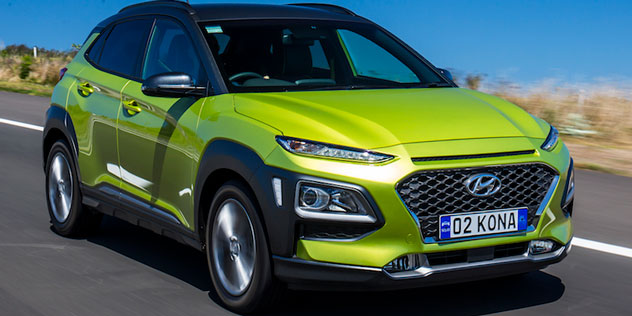
Hyundai’s CEO, JW Lee, reckons the Kona has come to the market at a perfect time for the brand, with some other carmakers’ models running outdated technology. It’s a fair assessment, but not entirely true for the CX-3 and HR-V, which are just three short years into their model cycles.
The Kona line-up is extensive, with Active, Elite and Highlander grades, 2WD and AWD, and the choice of two petrol engines – a 2.0-litre for 2WD versions and a more powerful 1.6-litre turbo petrol engine for the AWDs. Pricing starts at $24,500 for the Active 2.0-litre and goes up to $36,000 for the 1.6-litre Highlander AWD. We drove the Elite 2WD, priced at $28,500.
The Kona is built on a new platform shared with the new i30 hatch and, size-wise, Hyundai claims it’s one of the more compact vehicles in the class. Compared to the HR-V, the Kona is shorter, a touch wider and similar in height.
Hyundai's 2.0-litre four-cylinder powers the 2WD Elite, developing 110kW and 180Nm, and is matched to a six-speed automatic transmission. AWD Elites use Hyundai’s more powerful 130kW/265Nm turbo 1.6-litre four-cylinder, and seven-speed dual clutch transmission. Claimed fuel consumption for the 2.0-litre is 7.2L/100km.
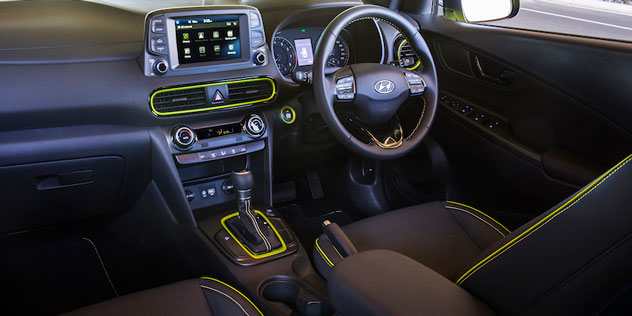
Little separates the engines in the Hyundai, Mazda and Honda, with just 6kW and 20Nm between them, and claimed fuel consumption figures are similarly close. Those differences are hard to pick up on under daily driving and, predictably, the on-road performance from the 2.0-litre in the Kona matches the CX-3 and HR-V. The six-speed automatic’s spread of ratios is nicely matched to the engine’s characteristics, and it’s only towards its maximum of 6000rpm where engine noise starts to become obvious and intrusive. Over our drive loop we returned 6.7L/100km, equal to the CX-3.
The 2WD suspension design is conventional, like the CX-3 and HR-V, but the AWD Kona uses a more sophisticated multi-link design. Locally, Hyundai evaluated a number of different damper, spring and stabiliser bar combinations for our road conditions, before settling on different combinations for the 2WD and AWD versions. The Elites come with 17-inch alloys and low-profile tyres, and the resulting ride is a little firmer but not unsettling.
While the Kona’s exterior has a certain presence, the protective cladding around the wheel arches emphasises its SUV look, and a bright colour palate is on offer for buyers, the overall design is perhaps not as coherent as that in the CX-3 or the HR-V.
Hyundai’s CEO is right about the fast-paced changes in technology and nowhere are they more evident than in the Kona’s headlamp design. Thin LED daytime running lights sit high either side of the mesh grille, with the headlights separate and mounted lower, giving the Kona a distinctive look that’s on trend with the latest designs from Europe.
Inside the cabin, the stand-alone seven-inch infotainment screen sits up in the dash next to the instrument cluster, lowering the overall dash height and providing an open airy feel. The major controls are well laid out, the digital speed readout is a plus, and the driving position feels good ergonomically. Satin finish trims on the air vents and doors provide a lift to the predominantly grey trim materials. Our test Elite was fitted with optional coloured trims around the air vents. Sometimes this type of treatment can look contrived, but we gave it the thumbs up on the Kona. In space and luggage capacity, the Kona is similar to the other two in our comparison and, like the HR-V, it has a shallow compartment under the rear floor for small items.
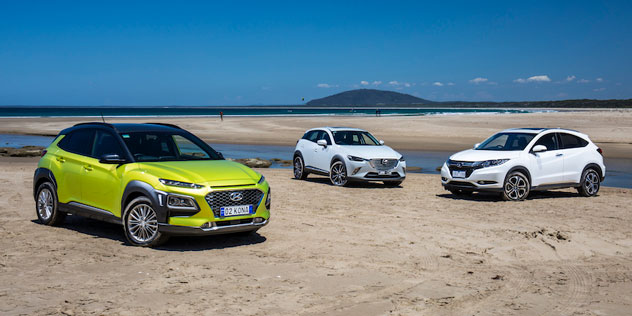
Depending on your needs, all three models deserve serious consideration. If space is a priority, the Honda HR-V has an advantage, especially over the Mazda CX-3’s cosy dimensions, and the package is only let down by its infotainment system. This sees the Hyundai Kona, as the newcomer of the trio, being able to best fill the brief for balancing performance, handling, styling, features and a reasonable amount of luggage room.
This story first appeared in the NRMA's Open Road magazine - January/ February 2018 Issue